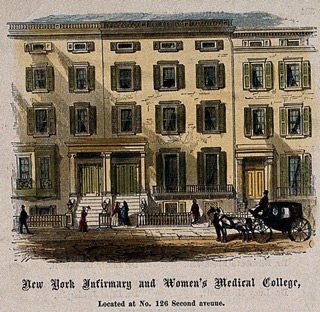“Miss Monelle is quite a character.”
Lavinia Goodell, November 21, 1869
In 1869, in an effort to improve her German language skills, Lavinia Goodell moved from her aunt and uncle’s home in Brooklyn into an upper room of a home on East 23rd Street in Manhattan owned by a German doctor. For a time she had a roommate who was a medical student at the Woman’s Medical College and Infirmary, an institution recently opened by sisters Elizabeth and Emily Blackwell. Lavinia found Nancie Monelle very companionable, although they had divergent interests.

Lavinia wrote to her sister:
My new chum is quite a character. She is short, plump, black eyed, rosy, jolly and good-natured. Supports herself and studies medicine. She is very gay, too, and quite a flirt, and fond of the gentlemen. We get along admirably, because I don’t care a fig for them & am quite willing she should have them all to herself…. Miss Monelle has already laid up money enough to take her thro’ the medical college. She has been a teacher several years.
Nancie Monelle was born in New York in 1841. Her ancestors were French. Her great grandfather had come to America with the young Marquis de Lafayette and liked the country so much that he never went home again. Nancie graduated from a college in Poughkeepsie, New York in 1861 and taught at various schools and colleges, including Vassar. While at Vassar she decided to study medicine. Mary Ann Wattles, a fellow student at the Woman’s Medical College and a longtime friend of Lavinia, recommended that the two women room together.
Lavinia enjoyed Nancie’s high spirits. She reported to her parents that they “have lots of fun laughing over the eccentricities of our German friends.” But at Christmas 1869, when the Germans stealthily tried to get the women drunk, teetotaling Lavinia was disappointed in Nancie, telling her sister:
My roommate had no conscience about the matter, but drank glass after glass till she dared not drink any longer & then pretended to & threw the wine away furtively, when they were not looking, all to be “social.” I was indignant at her, for she knows better.
By the spring of 1870, Nancie Monelle had taken a room at the medical college.

Although Lavinia did not mention her again, Nancie Monelle went on to have a distinguished career. She graduated from medical school in 1872 after writing her thesis on cholera and earning highest honors in surgery. In 1873, she became a physician missionary in India for the Woman’s Foreign Missionary Society of the Methodist Episcopal Church. She was the first woman physician to go alone into a native Indian state. According to the Missionary Society’s 1896 report, “The ruler of the province furnished elephants, a regiment of sepoys and a band of music to escort her to the palaces of the various noblemen.” After three years in India, after establishing a dispensary and hospital and treating 40,000 patients, she married Rev. Henry Mansell, a Methodist minister. The couple remained in India. In the 1880s, during a cholera epidemic, Dr. Mansell took charge of the dispensary with native assistants and was so successful that the Indian municipality sent her a handsome sum for the purchase of medicine.
In the 1890s, Dr. Mansell became appalled at the Indian custom of marriages being arranged for very young children, which sometimes resulted in grievous injuries, and even death, to the young girls. Dr. Mansell drew up a petition, signed by 55 other women physicians, raising the marriageable age for girls to fourteen. The government raised the marriageable age to twelve, which was seen as an important step in the domestic and social life of the Indian people.
Dr. Mansell died in India in 1903 and was buried there. Her husband died in 1911 and is buried in Poughkeepsie.
Sources consulted: Lavinia Goodell’s letters to Maria Frost (November 21, 1869 December 30, 1869;) Lavinia Goodell’s letters to William and Clarissa Goodell (November 28, 1869; March 21, 1870; April 17, 1870); Frances J. Baker, The Story of the Woman’s Foreign Missionary Society, Hunt & Eaton, New York (1896); Mary Sparkes Wheeler, First Decade of the Woman’s Foreign Missionary Society of the Methodist Episcopal Church, Phillips & Hunt, New York (1893); Janice P. Nimura, The Doctors Blackwell, W. W. Norton & Co. (2021).







